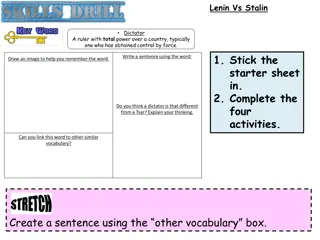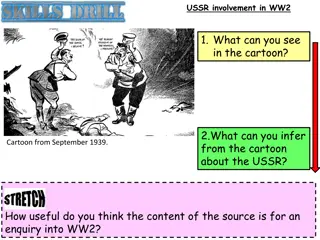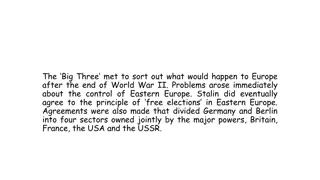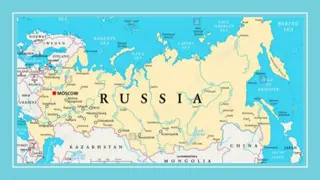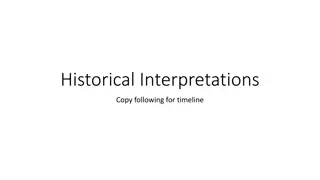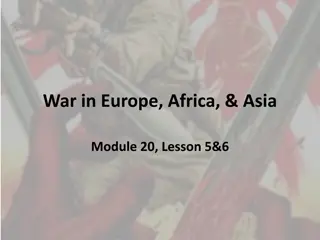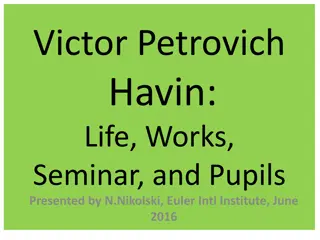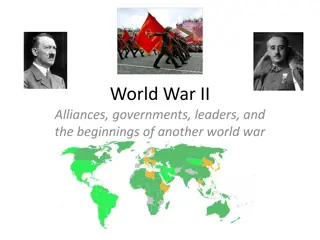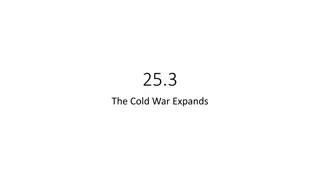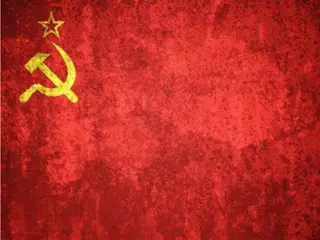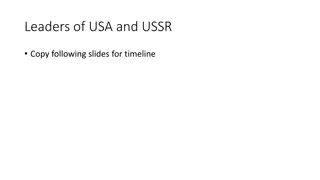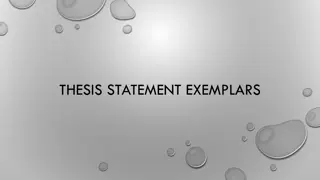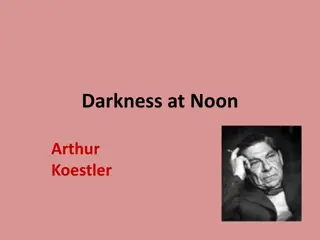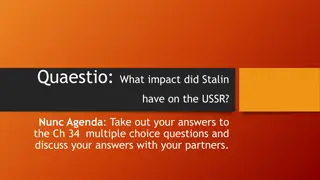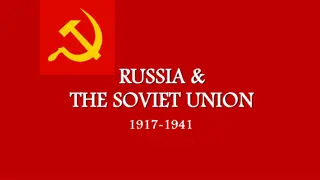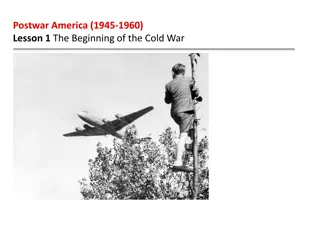Exploring Global Literary Radicalisms in the Soviet Era
The passage delves into the life of Margulies, detailing his meticulous routine and contemplation of time in the Soviet context. It reflects on themes of industrial progress, historical backwardness, and the intertwining of time and life. Additionally, it references Stalin's vision for economic adva
2 views • 18 slides
A Comparison of Lenin and Stalin: Impact on Russia
Vladimir Lenin and Joseph Stalin were prominent leaders in Soviet Russia who implemented different policies in areas such as governance, economy, and agriculture. Lenin initiated policies affecting land distribution and food production, whereas Stalin focused on industrialization and state control.
1 views • 12 slides
The USSR and Nazi Germany: The Pact of 1939
In the lead-up to WWII, the USSR signed a non-aggression pact with Nazi Germany, shocking the world. This pact included secret clauses dividing Poland and avoiding conflict for ten years. The USSR's alliance with Germany was a strategic move by Stalin due to fear of invasion and perceived weakness o
0 views • 13 slides
Post-World War II Division and Cold War Tensions in Europe
Big Three leaders post-World War II agreement on Eastern Europe control, division of Germany, Truman confronting Stalin, atomic bombings, USSR's influence in Eastern Bloc, Truman Doctrine against communism, US financial aid to combat communism in Europe.
5 views • 26 slides
The Ruthless Reign of Joseph Stalin in the Soviet Union
Joseph Stalin rose to power in the USSR after Lenin's death, implementing totalitarian control through purges, collectivization, and propaganda. His regime led to millions of deaths, forced labor camps, and a cult of personality, shaping Soviet society through fear and oppression.
0 views • 8 slides
Cold War Historical Interpretations Timeline
Explore different historical interpretations of the Cold War through three main perspectives: Traditional/Orthodox, Revisionist, and Post-Revisionist/Contemporary/Post-1991. The Traditional/Orthodox view blames Stalin for the breakdown of relations, the Revisionist view points to mutual provocations
1 views • 9 slides
The Rise of Totalitarian Regimes in World War II
In the aftermath of World War I, several European countries fell into economic depression and embraced totalitarian regimes led by leaders like Mussolini in Italy, Stalin in the Soviet Union, Hirohito in Japan, and Hitler in Germany. These leaders wielded total control over their citizens, militariz
0 views • 30 slides
World War II Campaigns in Europe, Africa, and Asia
The module discusses various campaigns during World War II in different regions such as the Atlantic, Eastern Front, North Africa, Italy, Western Front, and Pacific. It highlights significant battles like the Battle of Stalingrad in 1942, the strategic decisions made by leaders like Stalin, FDR, and
0 views • 18 slides
Victor Petrovich Havin: Life and Works Seminar Overview
Victor Petrovich Havin, a renowned mathematician, was born in 1933 in St. Petersburg. Despite facing challenges during World War II and the Soviet regime, he pursued his passion for mathematics and became a Professor at St. Petersburg University. His career included significant events such as Stalin
0 views • 31 slides
The Rise of Dictators and the Beginnings of World War II
The content delves into the events leading up to World War II, highlighting key historical moments such as the rise of dictators like Hitler, Mussolini, and Stalin, along with significant milestones such as the invasion of Poland and the bombing of Pearl Harbor. It emphasizes the ideologies of fasci
0 views • 48 slides
The Cold War Expansion and Nuclear Arms Race
The Cold War intensified as the Soviet Union detonated an atomic bomb, leading to heightened tensions. Communist advancements, including the takeover of communist China, shocked the world. Nuclear arsenals expanded with the development of the hydrogen bomb, sparking concerns of an arms race. Eisenho
0 views • 17 slides
The Rise of Communism in Russia: Key Figures and Events
Russia's transition to communism was marked by social and political upheaval, with figures like Karl Marx, Lenin, Trotsky, and Stalin playing pivotal roles. The Russian Revolution, civil war, and the rise of the Soviet Union reflected a shift towards communist ideology, leading to significant change
0 views • 37 slides
The Rise and Rule of Leaders in Russia: Marx, Lenin, and Stalin
The journey of political upheaval in Russia, from the writing of the Communist Manifesto by Marx and Engels to the rule of Lenin and the dictatorship of Stalin, marked by revolution, famines, purges, and the Great Terror.
0 views • 13 slides
Leadership Timeline: USA and USSR Leaders
Explore the timeline of leaders from the United States and the Soviet Union, showcasing significant figures such as Harry Truman, John F. Kennedy, Richard Nixon, Joseph Stalin, Nikita Khrushchev, and more. Witness the transitions in leadership that occurred during critical periods in history.
0 views • 8 slides
Legacies of Leadership: Stalin, Malcolm X, and Corazon Aquino
Explore the contrasting legacies of Joseph Stalin's harsh leadership during World War II, Malcolm X's civil rights activism inspiring unity and equality, and Corazon Aquino's surprising rise to lead the Philippines towards democracy. Each leader left a distinct mark on history, shaping nations and i
0 views • 4 slides
Analysis of "Darkness at Noon" by Arthur Koestler in Context of Russian Revolution and Succession
Explore the metaphoric context of "Darkness at Noon" by Arthur Koestler in relation to the Russian Revolution of 1917, succession issues following Lenin's rule, and the thematic elements of guilt, intention, and historical necessity within the Party's evaluation. Dive into the dramatis personae, int
0 views • 7 slides
Impact of Stalin on the USSR: Totalitarianism, Five-Year Plans, and the Great Purge
Stalin's rule in the USSR brought about significant changes through totalitarianism, economic central planning with Five-Year Plans, and brutal measures like collectivization and the Great Purge, resulting in widespread suffering and loss of life.
0 views • 12 slides
Transformation of Soviet Society Under Stalin's Rule
Stalin's impact on Soviet society and culture was significant, with a mix of promoting change and continuity. This essay evaluates the extent of transformation in areas such as standard of living, attitudes, arts, ethnicity, gender roles, and family life. While Stalin's conservative policies reinsta
0 views • 28 slides
The Beginning of the Cold War: Postwar America (1945-1960) Lesson 1
Postwar America (1945-1960) Lesson 1 explores the unraveling of the wartime alliance between the United States and the Soviet Union, President Truman's response to Soviet aggression in Eastern Europe, and the causes and results of Stalin's blockade of Berlin. The background of the Cold War, Soviet a
0 views • 22 slides

